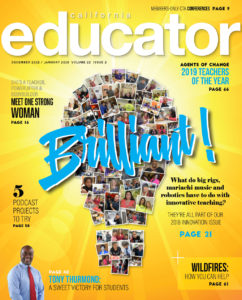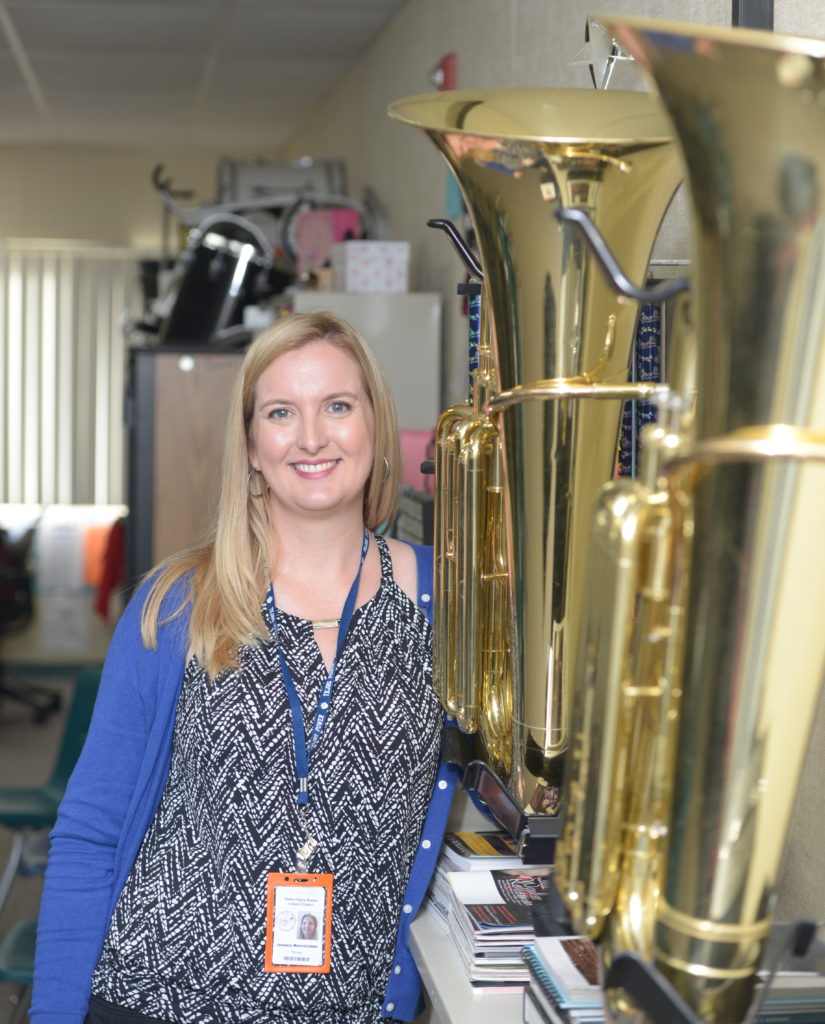2018 Innovator, Santa Maria Elementary Teachers Association
Mariachi music is loud, joyful, and has roots in Mexico. The same can be said for most students in Jessica Husselstein’s mariachi program at Tommie Kunst Jr. High School in Santa Maria, who happily perform this traditional Mexican music associated with cultural celebrations.
The seventh- and eighth-graders show up twice a week 30 minutes before the school bell rings, eager to play a variety of
instruments including guitars, violins and trumpets. Some strum along on the vihuela, a high-pitched, roundbacked guitar that provides rhythm, or a bass guitar called a guitarrón, which also provides rhythm. Singing along in Spanish is encouraged.
Some students know how to play musical instruments because they perform in the school band. Others learn as they go along, with
help from Husselstein and parent volunteers, including Rebecca Fuhriman, who learned how to play the violin through osmosis after sitting
through hundreds of violin lessons with her children.
“You sound fabulous,” Husselstein tells her students. “I’m so proud of you.”
Brilliant! Our 2018 Innovation Issue

These educators translate ideas, inventions and ways of doing things into something profound and often magical
Tricia Hyun, et al – English teachers find gamification a winner
Dan Frank – Manufacturing student success
Monique Flores & Ann Jensen – Program fosters freshman connection
Brandy Peters – Tech educator levels the playing field
Virginia Marshall – Honoring black student achievement
Jesse Barnett – Students use cameras to get in touch with the world
Rose Borunda – Changing the California Indian history narrative
GALA – All-girls STEM school builds equity and skill
Dave Dein – Teaching truck-driving skills
Sharing the Sounds of Success is the name of the program Husselstein created last year, after receiving a two-year grant from CTA’s Institute for Teaching to pay for some of the musical instruments and other expenses. The program is so popular that she hopes it eventually becomes a regular class that will attract younger students from feeder schools.
“I really like it,” says seventh-grader Victor Cambero, who plays trumpet in both the mariachi club and school band, which Husselstein also directs. “I like being able to express my Mexican heritage through music. It makes me feel proud of my culture. I really like Mrs. Husselstein and the way she’s committed to mariachi. I’m looking forward to performing in my community.”
Nayeli Fargan, also in seventh grade, decided to take up guitar for the mariachi band. She plays clarinet in the school band.
“Playing mariachi music makes me happy, and it makes my parents proud,” she says.
Not all of the mariachi students are Latino; a few are white and Filipino. “Everyone is welcome,” Husselstein says. “I love to see the cultures mixing it up and enjoying music together.”

Whether or not we receive the training to develop [our inherent musical] ability should not be left to socioeconomic status or the values of administration at school sites.”
She is an unlikely mariachi teacher. The blond-haired, blue-eyed Santa Maria Elementary Teachers Association member taught traditional instrumental music for nearly two decades, but after meeting mariachi performers at a friend’s party, she thought it would be a great way to connect with students at her campus, which has a student population that is 90 percent Hispanic.
“Some of my students feel a disconnectbetween school and their culture, and I thought this would be a wonderful way of reaching out and making connections,” she explains. “Sometimes I’m out of my comfort zone, but the kids are willing to invite me into their culture, and it’s super special.”
She adds, “Mariachi resonates with them. It is familiar and respected in their home. Mom and dad start singing along while they are practicing, or hug them a little tighter after a performance, because the music brings them together.”
Parents have indeed jumped on board. Several purchased or rented musical instruments because Husselstein did not have enough to go around. Many attended the school’s Musician and Parent Learning Night. And parents have accompanied students as “guest artists,” playing musical instruments and singing.
She believes that every human being is inherently musical.
“Whether or not we receive the training to develop that ability should not be left to socioeconomic status or the values of administration at school sites. It’s time for California to reinstate high quality, standards-based music and arts education.”
Teaching the mariachi program is fun but extremely challenging, says Husselstein — who plays every instrument but accordion — because there are so many instruments. She compares it to teaching algebra, geometry and calculus at the same time to students of differing abilities.
“It’s a juggling act, but worth it,” she says. “When I see that energy and happiness and how invigorated these kids become, I realize how important it is for us to work together toward new levels of learning.”
The Discussion 0 comments Post a Comment